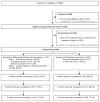An intervention to extend breastfeeding among black and Latina mothers after delivery
- PMID: 24262719
- PMCID: PMC3938878
- DOI: 10.1016/j.ajog.2013.11.028
An intervention to extend breastfeeding among black and Latina mothers after delivery
Abstract
Objective: The purpose of this study was to compare breastfeeding duration in mothers after delivery who were assigned randomly to a behavioral educational intervention vs enhanced usual care.
Study design: We conducted a randomized trial. Self-identified black and Latina mothers early after delivery were assigned randomly to receive a behavioral educational intervention or enhanced usual care. The 2-step intervention aimed to prepare and educate mothers about postpartum symptoms and experiences (including tips on breastfeeding and breast/nipple pain) and to bolster social support and self-management skills. Enhanced usual care participants received a list of community resources and received a 2-week control call. Intention-to-treat analyses examined breastfeeding duration (measured in weeks) for up to 6 months of observation. This study was registered with clinicaltrial.gov (NCT01312883).
Results: Five hundred forty mothers were assigned randomly to the intervention (n = 270) vs control subjects (n = 270). Mean age was 28 years (range, 18-46 years); 62% of the women were Latina, and 38% were black. Baseline sociodemographic, clinical, psychosocial, and breastfeeding characteristics were similar among intervention vs control subjects. Mothers in the intervention arm breastfed for a longer duration than did the control subjects (median, 12.0 vs 6.5 weeks, respectively; P = .02) Mothers in the intervention arm were less likely to quit breastfeeding over the first 6 months after delivery (hazard ratio, 0.79; 95% confidence interval, 0.65-0.97).
Conclusion: A behavioral educational intervention increased breastfeeding duration among low-income, self-identified black and Latina mothers during the 6-month postpartum period.
Keywords: breastfeeding; intervention; minority; postpartum; randomized trial.
Copyright © 2014 Mosby, Inc. All rights reserved.
Figures


References
-
- Singh GK, Kogan MD, Dee DL. Nativity/immigrant status, race/ethnicity, and socioeconomic determinants of breastfeeding initiation and duration in the United States, 2003. Pediatrics. 2007 Feb;119 (Suppl 1):S38–46. - PubMed
-
- Gartner LM, Morton J, Lawrence RA, et al. Breastfeeding and the use of human milk. Pediatrics. 2005 Feb;115(2):496–506. - PubMed
-
- Pettigrew MM, Khodaee M, Gillespie B, Schwartz K, Bobo JK, Foxman B. Duration of breastfeeding, daycare, and physician visits among infants 6 months and younger. Ann Epidemiol. 2003 Jul;13(6):431–435. - PubMed
-
- Racial and ethnic differences in breastfeeding initiation and duration by state - National Immunization Survey, United States, 2004–2008. MMWR Morb Mortal Wkly Rep. 2010 Mar 26;59(11):327–334. - PubMed
-
- Chapman DJ, Damio G, Young S, Perez-Escamilla R. Effectiveness of breastfeeding peer counseling in a low-income, predominantly Latina population: a randomized controlled trial. Arch Pediatr Adolesc Med. 2004 Sep;158(9):897–902. - PubMed
Publication types
MeSH terms
Associated data
Grants and funding
LinkOut - more resources
Full Text Sources
Other Literature Sources
Medical
Miscellaneous

